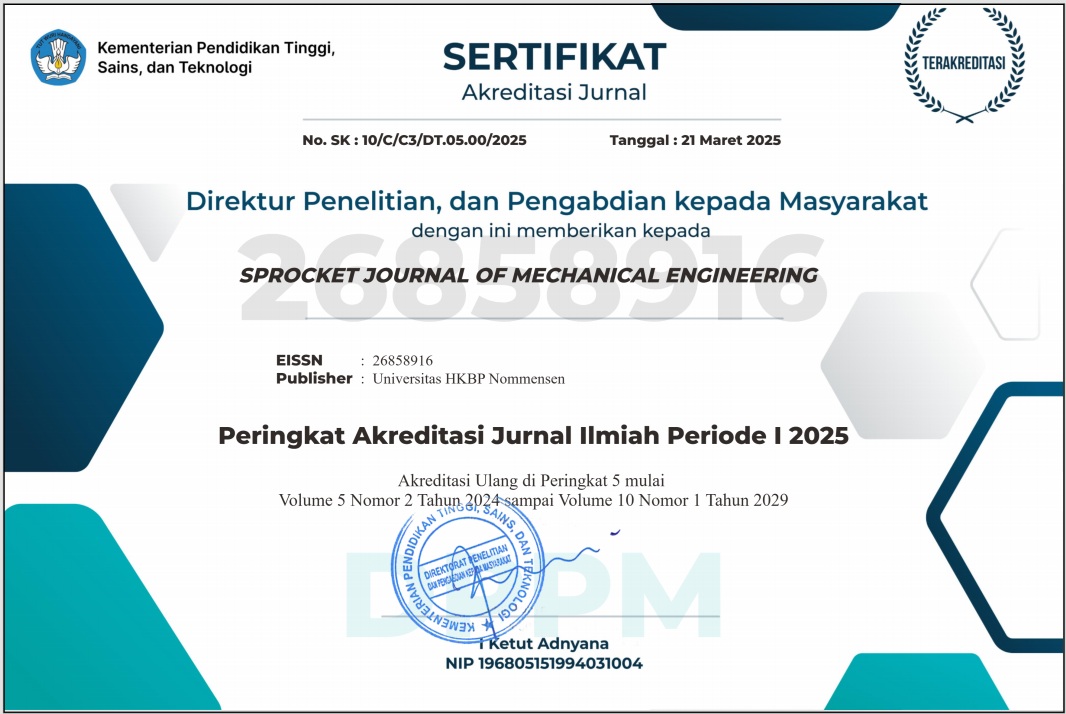Pengembangan Panel Surya 120 Wp Dengan Solar Tracker Double Axis Sebagai Bahan Pembelajaran Mahasiswa di Program Studi Teknik Mesin UHN
Abstract
The current need for electrical energy sourced from fuel oil is increasingly running out and expensive. Anticipating future energy crises will require creativity from energy observers in finding alternative energy sources that can improve people's welfare. We get solar energy for free throughout the year with good intensity, one of which is because Indonesia's position is on the equator. To convert solar heat from the outside into electrical energy, several converter technologies such as solar panels are needed. Solar panels that are directly exposed to solar radiation can produce efficient electrical energy depending on the position of the incident light that hits the surface of the solar panel. Solar panels that can follow the direction of the radiation source at an angle of 90o to the surface of the solar panel must require a solar tracker. Solar tracker is a control circuit that is able to detect and follow the direction of the sun so that the solar panel is always perpendicular to the sun so that the light intensity received by the panel is optimal by adjusting the motor movement. The results of this study indicate a light intensity of 408.10 W/m2 at a wind speed of 1.08 m/s produces a current of 19.20 Volts with an efficiency level of 4.21% at the incoming energy (Pin) 279.05 and the outgoing energy ( Pout) 11.77 W.
References
[2] C. Sungur, “Multi-axes sun-tracking system with PLC control for photovoltaic panels in urkey,” Renewable Energy, vol. 34, no. 4, hal. 1119–1125, 2009.
[3] J. K. Tharamuttam dan A. K. Ng, “Design and Development of an Automatic Solar Tracker,” Energy Procedia, vol. 143, hal. 629–634, 2017.
[4] W. Indrasari, R. Fahdiran, E. Budi, L. Jannah, L. V. Kadarwati, dan Ramli, “Active Solar Tracker Based on the Horizon Coordinate System,” in Journal of Physics: Conference Series, 2018, vol. 1120, no. 012102, hal. 1–5.
[5] PT PLN, Rencana Usaha Penyediaan Tenaga Listrik 2019-2028, Jakarta, 2019.
[6] A. El Hammoumi, S. Motahhir, A. El Ghzizal, A. Chalh, dan A. Derouich, “A simple and low-cost active dual-axis solar tracker,” Energy Science and Engineering, vol. 6, no. 5, hal. 607–620, 2018.
[7] M. Khairudin dan S. Adyarno, “Solar Tracker on Solar Home System to Optimize Sunlight Absorption,” Journal of Physics: Conference Series, vol. 1140, no. 012005, hal. 1–5, 2018.
[8] L. Barker, M. Neber, dan H. Lee, “Design of a low-profile two-axis solar tracker,” Solar Energy, vol. 97, hal. 569–576, 2013.
[9]. Abadi, I., Musyafa, A., & Soeprijanto, A. (2015). Design and Implementation of Active Two Axes Solar Tracking System Using Particle Swarm Optimization Based Fuzzy Logic Controller. International Review on Modelling and Simulations (I.RE.MO.S.)
[10]. Jain, D. S., & Cheema, S. S. (2012). Simulation Studies on Dual Axis Solar Photovoltaic Panel Tracking System. Patiala: Electrical & Instrumentation Engineering Department Thapar University
[11] X. Berisha, A. Zeqiri, and D. Meha, “Determining the optimum tilt angles to maximize the incident solar radiation-case of study Pristina,” International Journal of Renewable Energy Development, vol. 7, no. 2, hal. 123–130, 2018.
[12] T. O. Kaddoura, M. A. M. Ramli, and Y. A. Al-Turki, “On the estimation of the optimum tilt angle of PV panel in Saudi Arabia,” Renewable and Sustainable Energy Review, vol. 65, hal. 626–634, 2016.
[13] P. D.L., Hermawan, and Karnoto, “Analisis sudut panel solar cell terhadap daya output dan efisiensi yang dihasilkan,” Transient: Jurnal Ilmiah. Teknik Elektro, vol. 2, no. 4, hal. 930–937, 2013.
[14] V. Poulek, A. Khudysh, dan M. Libra, “Self powered solar tracker for Low Concentration PV (LCPV) systems,” Solar Energy, vol. 127, hal. 109–112, 2016.
[15] A. O. Ndubuisi, E. Imolorhe, dan M. L. Akinyemi, “Investigating the effect of solar trackers on solar energy harnessing in the Tropics,” in IOP Conference Series: Earth and Environmental Science, 2018, vol. 173, no. 012044, hal. 1–7.
[16] http://www.apscupsc.com/daily-current-affairs-3-january-2018/
[17]. Ambarita, Himsar,2011 "Energi Surya", Medan , Departemen Teknik Mesin Universitas Sumatera Utara.
[18] Duffie, Jhon A, and A William Backman, 2013 "Solar Engineering of Thermal Process", 4thNew Jersey, Jhon Wiley and sin, inc.
[19] Swami, Rashmi. 2012, "Solar Cell", Department of Electronics, Govt.Girl's polytechnic Raipur, 492001, Chhattisgarh, India
[20] .https://id.wikipedia.org/wiki/Sel_surya
[21] R. Singh, S. Kumar, A. Gehlot, and R. Pachauri, "An imperative role of sun trackers in photovoltaic technology: A review, " Renew. Sustain. Energy Rev., vol. 82, no. October, pp. 3263-3278, 2018.
[22]. Jain, D. S., & Cheema, S. S. (2012). Simulation Studies on Dual Axis Solar Photovoltaic Panel Tracking System. Patiala: Electrical & Instrumentation Engineering Department Thapar University.
[23]. Zhao, L. H., Chongyang, W., & Hao , X. L. (2014). An Improved PV System Based on Dual Axis Solar Tracking and MPPT. Proceedings of 2014 IEEE International Conference on Mechatronics and Automation, China.

This work is licensed under a Creative Commons Attribution 4.0 International License.
Penulis yang menerbitkan dengan SPROCKET JOURNAL OF MECHANICAL ENGINEERING menyetujui ketentuan berikut :
- Penulis memegang hak cipta dan memberikan jurnal hak penerbitan pertama dengan karya yang dilisensikan secara bersamaan di bawah Lisensi Internasional Creative Commons Atribusi 4.0 . yang memungkinkan orang lain untuk berbagi karya tersebut dengan pengakuan atas kepengarangan karya dan penerbitan awal dalam jurnal ini.
- Penulis dapat membuat pengaturan kontraktual tambahan yang terpisah untuk distribusi non-eksklusif atas versi jurnal yang diterbitkan dari suatu karya (misalnya, mempostingnya ke repositori institusional atau menerbitkannya dalam sebuah buku), dengan pengakuan atas penerbitan awalnya di jurnal ini.
- Penulis diizinkan dan didorong untuk mengunggah karya mereka secara daring (misalnya, di repositori institusi atau di situs web mereka) sebelum dan selama proses penyerahan, karena hal ini dapat mengarah pada pertukaran yang produktif, serta kutipan yang lebih awal dan lebih banyak dari karya yang diterbitkan (Lihat Pengaruh Akses Terbuka ).






.png)
.png)

